Menus
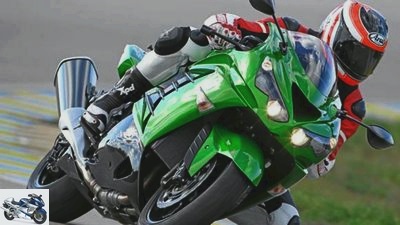
Image:
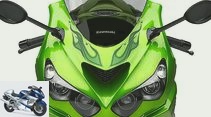

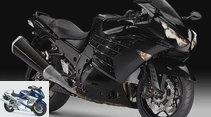
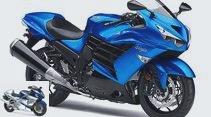
18th photos
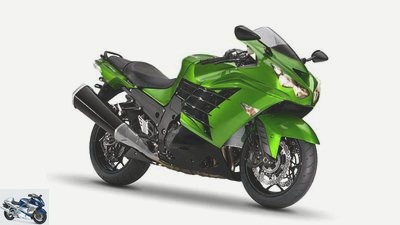
Kawasaki
1/18
Kawasaki’s full-bodied announcement for the ZZR 1400: "The production motorcycle with the fastest acceleration in the world".
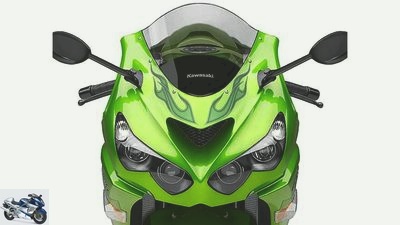
Kawasaki
2/18
Kawasaki has not yet disclosed precise performance data for the ZZR 1400. It should have more power and torque than the previous model. So more than 154 Nm of torque and more than 193 hp peak power.
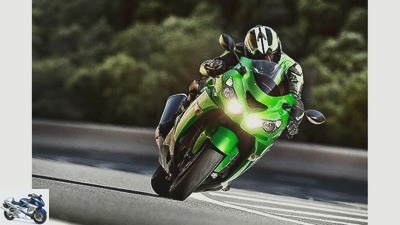
Kawasaki
3/18
The traction control of the new Kawasaki ZZR 1400 works in three modes.
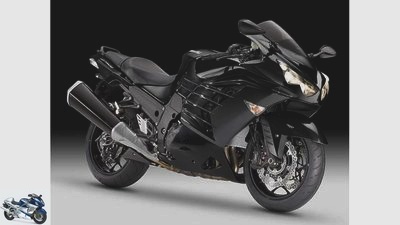
Kawasaki
4/18
Kawasaki ZZR 1400 model year 2012 in black.
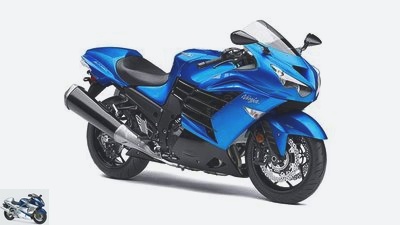
Kawasaki
5/18
Kawasaki ZZR 1400 model year 2012 in blue.
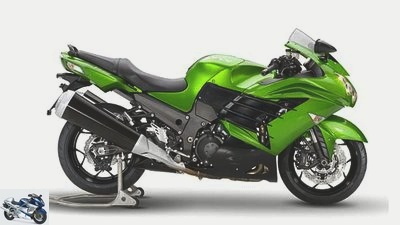
Kawasaki
6/18
Kawasaki ZZR 1400 model year 2012: The exhaust mufflers are already maliciously compared to school cones on the Internet.
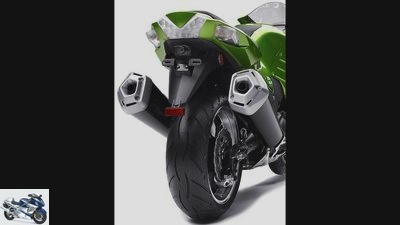
Kawasaki
7/18
Kawasaki ZZR 1400 model year 2012 rear view.

Kawasaki
8/18
Kawasaki ZZR 1400 model year 2012: the upper part and sides of the fairing are new.
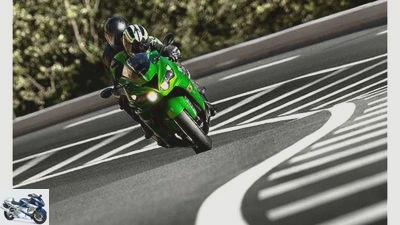
Kawasaki
9/18
Kawasaki ZZR 1400 model year 2012
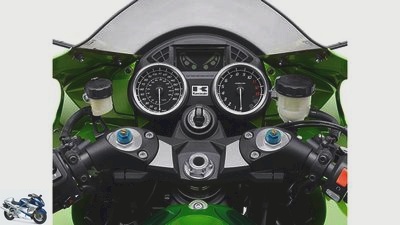
Kawasaki
10/18
Kawasaki ZZR 1400 model year 2012 cockpit.
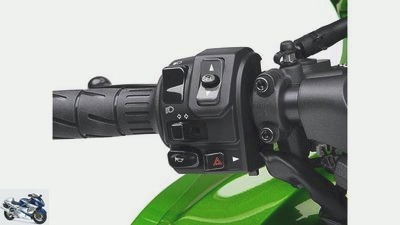
Kawasaki
11/18
Kawasaki ZZR 1400 model year 2012
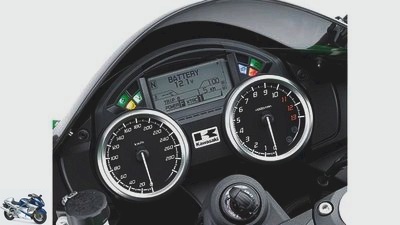
Kawasaki
12/18
Kawasaki ZZR 1400 model year 2012
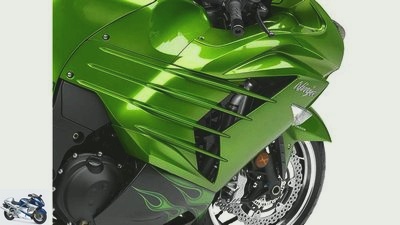
Kawasaki
13/18
Kawasaki ZZR 1400 model year 2012
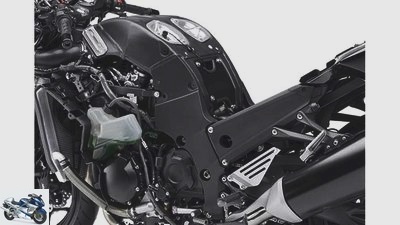
Kawasaki
14/18
Kawasaki ZZR 1400 model year 2012
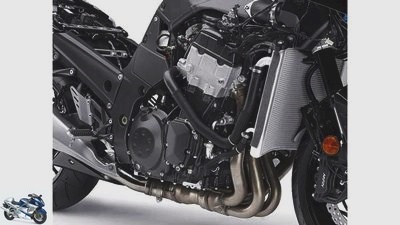
Kawasaki
15/18
Kawasaki ZZR 1400 model year 2012
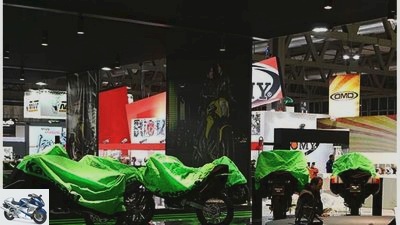
Gram
16/18
The new Kawasaki products are waiting to be unveiled on the eve of Eicma.
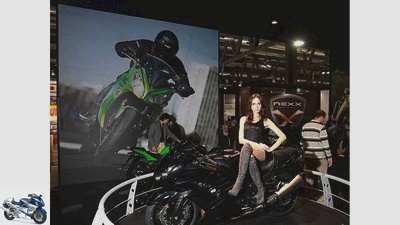
Gori
17/18
Overall, the Kawasaki stand in Milan is pretty dark.
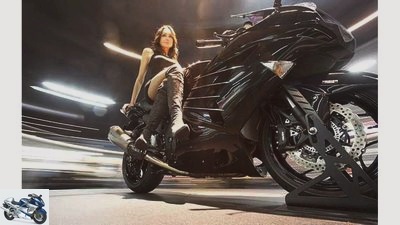
Gori
18/18
That doesn’t prevent the Kawasaki machines from being attractively presented, such as the new, super-powerful ZZR 1400.
The strongest motorcycle in the world
Driving report: Kawasaki ZZR 1400
It’s like always. When someone is stronger or faster, the Kawasaki engineers get nervous. Then they get started and work until they say again: The most powerful bike in the world is a Kawa. That’s the way it has to be.
Ever heard of Pavlov’s reflex? Nobel laureate Ivan Pavlov let his dogs ring a bell at every meal, whereupon their mouths began to water while tinkling, even without food. A learned reflex that cannot be turned off easily.
You have to imagine something similar in some Kawasaki offices: The men from the power department, they just can’t help themselves. Except that instead of the bell, the latest performance data from the competition is ringing in their ears. And off they go: more horsepower for Kawasaki, more top speed too – something has to be done.
Seen in this light, it is a bit surprising that the youngest ZZR 1400 was a long time coming. Only now, years after Suzuki has taken the lead in the mighty-strong-and-fast segment again with the Hayabusa and nominally 197 hp, is Kawasaki following suit. With a promised 200 PS (without back pressure!), With a prospect of 210 PS (under full Ram-Air influence).
S.he is definitely the production motorcycle with the world’s best acceleration – say Kawasaki’s spokesman. You can literally feel how they twist. They would love to say not only that, but something else as well. Would speak plain language, show what really goes out at the top. The fastest production motorcycle in the world, that would be an announcement.
Buy complete article
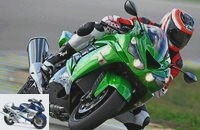
The strongest motorcycle in the world
Driving report: Kawasaki ZZR 1400
Kawasaki ZZR 1400 with measured 180 PS (nominal output 190 PS) made it. Nevertheless, the Greens have hardly left a screw as it was in order to land at the top again, at least in terms of performance.
Of course, the powerful engine was the focus of interest. Four millimeters more stroke, revised channels, longer valve stems, sharper camshafts, lighter pistons with spray oil cooling of the piston crowns, optimized bypass openings (to minimize pumping losses), reinforced crankshaft bearings, new throttle valve housing, conical manifold pipes with larger diameter, new silencers, and, and and.
The list could be continued indefinitely. Much more exciting, however, is: Was the effort worth it? Can the new ZZR buy the cutting edge from the old one and everyone else over the entire speed range? Of course, the first driving report cannot provide any information about this without exact measurement data, but the chances are not that bad. It feels like the new one marches even more confidently through the gigantic engine speed range between 1000 and 11000 rpm. Despite the increase in displacement (now even 1441 instead of the previous 1352 cubic centimeters), it still does not deliver the insane pressure at very low speeds, but afterwards it is all the more decisive to get started. The engine adopts fine gas, the 84 pistons balance their torque on the crankshaft as smoothly as silk. Full, but never surprising, the thickness (manufacturer information 268 kilograms) pushes forward mightily. It’s beautiful like this, it could go on like this, it shoots through your head. That is acceleration in the most cultivated form, without any fidgeting or screeching. But just thinking about it, the picture changes again. – Beyond 7000 rpm, the green low-flying aircraft mutates again, now into a jet. Presses exhaust gases through the two huge muffler bags at high pressure, compressing time and space. Until then, at 10500 rpm, the shift light warns and finally at 11000 rpm the limiter puts a gracious end to the violent behavior.
Where can you experience this impetuous forward thrust without fear for your license and health, you ask? It is sure to be a very special experience that is hard to get on the way to work. Kawasaki had therefore chosen the high-speed track in the southern Italian city of Nardo to demonstrate its strength, where not only can you drive at full throttle, but the dragstrip and handling course also provide information about the extra-engine qualities.
Gargolov
Classic clocks, digital displays for traction control and motor mode.
Of course, the performance fetishists from the company headquarters in Kobe have also thought about how to keep the unleashed violence in check. Therefore, they not only tinkered diligently on the engine, but also on the periphery. The goal: more sportiness, i.e. a stiffer frame, a stiffer, dampened chassis, lighter wheels, sporty initial tires (Bridgestone BT 020).
All right, all logical, but: Of course, this combination of powerful pressure and a lot of weight is even more difficult to master than a pure athlete. This succeeds most confidently on the dragstrip, where the ZZR 1400, thanks to its long wheelbase (1480 millimeters) and another ten millimeters longer swing arm, as well as its high weight, keeps its front wheel largely on the ground and certainly burns excellent acceleration values into the asphalt.
The second top discipline: the high-speed rondola, where the Kawa not only easily shakes speeds of up to around 280 km / h out of its sleeve, but also manages them with ease. Beyond this mark, when the limiter suddenly puts an end to the forward thrust that is still present at just under 300 km / h, a slight stir around the steering head should be noted. Not questionable or frightening, but ubiquitous. An experience that, even in the German motorway reality, will rarely be savored.
Which brings us to the handling course and thus more to everyday life on federal and country roads. By no means at a slow pace, but rather relaxed, the first laps are tackled. Not too late on the brakes, not too early on the accelerator. Shift little, rather leave it in high gear and let the load run properly.
This is the world of ZZR, that’s where she feels at home. Steers neutrally, cushions and dampens comfortably, while the driver makes himself comfortable as if on the living room couch at home. ABS, new, three-stage traction control, new anti-hopping clutch? Not interested in anything now, the ZZR celebrates the speedy GT style, indulges in its determination.
But then comes what has to come. The rhythm becomes faster, the revs higher – and the power of a good 1400 cubic meters and around 200 hp catches up with you. Pushes out of the corners so vehemently that the fat man jerks the handlebars vigorously – there is no steering damper. And so the next bend is inevitably there faster than expected. Oops, drop anchor, but with flavor. It slows down, but the pounds push relentlessly. Not very clear the pressure point. The effect – more bite would be helpful now. So pull hard, the ABS will fix it in case of doubt. No question about it, the four-piston calipers really work. And in the end they seem overwhelmed, the brake lever moves further and further towards the handlebars.
The ZZR 1400 is not a racing machine after all, even if it is called Ninja ZX-14R in Japan and the USA and thus seeks to be close to the super sports car. With us you would rather use them for the well-kept weekend trip, maybe add suitcases. But there is no such thing as a topcase and spoiler screen. Accessories that are probably more important in Europe than records on the drag strip.
Changes
Gargolov
Longer swing arm, lighter wheels: the chassis technicians spared no effort.
- Now a real 1400: The stroke grew by four millimeters from 61 to 65 millimeters, the displacement from 1352 cubic centimeters to 1441 cubic centimeters. The maximum torque increased from 154 to 163 Newton meters.
- 200 HP: After the ZX-10R, the ZZR 1400 is the second Kawasaki for which a nominal 200 hp (at 10,000 rpm) is promised, with a maximum dynamic pressure even 210. The predecessor had 190 hp at 9500 rpm (200 hp with max. Dynamic pressure).
- Shorter secondary translation: The sprocket grew from 41 to 42 teeth, and the primary gear ratio became shorter .
- Changed frame: The characteristic monocoque frame of the ZZR 1400 retained its basic layout, but was adapted in the steering head and swing arm area. The swing arm is ten millimeters longer.
- Firmer chassis: harder springs in fork and shock absorber, new, tighter damper settings.
- Lighter wheels: The new ten-spoke wheels are much lighter. 360 grams were saved on the front wheel and 1030 grams on the rear wheel.
- New traction control: The new traction control has three levels. The first two for optimal conditions, the third for rain and slippery conditions. There are two motor mappings for this.
- New slipper clutch.
Technical specifications
Gargolov
Kawasaki ZZR 1400 2012.
engine
Water-cooled four-cylinder four-stroke in-line engine, two balance shafts, two overhead, chain-driven camshafts, four valves per cylinder, cup tappets, wet sump lubrication, injection, Ø 44 mm, regulated catalytic converter with secondary air system, 490 W alternator, 12 V / 14 Ah battery, hydraulic actuated multi-plate oil bath clutch, six-speed gearbox, O-ring chain, secondary ratio 42:17.
Bore x stroke 84.0 x 65.0 mm
Cubic capacity 1441 cm³
rated capacity 147.0 kW (200 hp) at 10,000 rpm
Max. Torque 163 Nm at 7500 rpm
landing gear
Monocoque made of aluminum, up-side-down fork, Ø 43 mm, adjustable spring base, rebound and compression damping, two-arm swing arm made of aluminum, central spring strut with lever system, adjustable spring base, rebound and compression damping, double disc brake at the front, Ø 310 mm, four-piston fixed calipers , Rear disc brake, Ø 250 mm, two-piston fixed caliper, traction control, ABS.
Cast aluminum wheels 3.50 x 17; 6.00 x 17
Tires 120/70 ZR 17; 190/50 ZR 17
Dimensions + weights
Wheelbase 1480 mm, steering head angle 67.0 degrees, caster 94 mm, spring travel f / h 117/122 mm, weight ready for use 268 kg, tank capacity 22 l.
Two year guarantee
Colors black, green
price 15595 euros
Additional costs 180 euros
Related articles
-
Presentation of the Kawasaki 1400 GTR and ZX-6R
Introduction of the Kawasaki 1400 GTR and ZX-6R Quantum leap of the Kawasaki GTR 1000? Exactly, this is this tourer, which was built almost unchanged from 1986 to 2003 …
-
fact 5 photos Kawasaki 1/5 Kawasaki 2/5 Kawasaki 3/5 Kawasaki 4/5 Kawasaki 5/5 Top test Kawasaki 1400 GTR The Kawa-Über-Tourer Superlatives are a…
-
Kawasaki Z 1000 SX in the driving report
Photo: Kawasaki 11 photos Kawasaki 1/11 The LED headlights are part of the new front fairing. They should shine brighter and wider at the same time….
-
Suzuki Hayabusa versus Kawasaki ZZR 1400 Speedbikes 2012
Comparison test: Speedbikes 2012 Suzuki Hayabusa versus Kawasaki ZZR 1400 It’s like always. They are never in agreement. “High speed – what,…
-
Driving report Kawasaki ZZR 1400
Artist Driving report Kawasaki ZZR 1400 (2006) Full program With the ZZR 1400, performance is program: 200 HP make it the most powerful series machine of…
-
Kawasaki W 800: vertical shaft motorcycle put to the test
Gargolov 29 photos Sdun / Jahn / Kawasaki 1/29 Kawasaki W 800: different tank designs. Sdun 2/29 Kawasaki W 800: different tank designs. Sdun / Jahn /…
-
Jahn Review Kawasaki ZZR 1400 Silver surfer Stronger, cleaner, sharper: The 2008 Kawasaki ZZR 1400 comes with a G-Kat, more steam and many fine…
-
Driving report: Kawasaki 1400 GTR
Kawasaki Driving report Kawasaki 1400 GTR (2009) Sporty touring machine With many changes in detail, a combination brake and even a traction control, the…
-
Reader’s test: the most powerful bikes of all classes
Gargolov MOTORRAD readers as test crew (video) The strongest bikes of all classes MOTORRAD invited six owners of the strongest bikes of all categories to …
-
New items 2012: Kawasaki KX 450 F
Manufacturer 18 pictures Manufacturer 1/18 New items 2012: Kawasaki KX 450 F Manufacturer 2/18 The Kawasaki KX 450 F has a narrower aluminum frame and a …